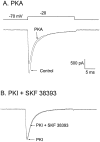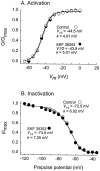Whole-cell plasticity in cocaine withdrawal: reduced sodium currents in nucleus accumbens neurons
- PMID: 9412525
- PMCID: PMC6793427
- DOI: 10.1523/JNEUROSCI.18-01-00488.1998
Whole-cell plasticity in cocaine withdrawal: reduced sodium currents in nucleus accumbens neurons
Abstract
The nucleus accumbens is a forebrain region that mediates cocaine self-administration and withdrawal effects in animal models of cocaine dependence. Considerable evidence suggests an important role of dopamine D1 receptors in these effects. Using a combination of current-clamp recordings in brain slices and whole-cell patch-clamp recordings from freshly dissociated neurons, we found that nucleus accumbens neurons are less excitable in cocaine withdrawn rats because of a novel form of plasticity: reduced whole-cell sodium currents. Three days after discontinuation of repeated cocaine injections, nucleus accumbens neurons recorded in brain slices were less responsive to depolarizing current injections, had higher action potential thresholds, and had lower spike amplitudes. Freshly dissociated nucleus accumbens neurons from cocaine-pretreated rats exhibited diminished sodium current density and a depolarizing shift in the voltage-dependence of sodium channel activation. These effects appear to be related to enhanced basal phosphorylation of sodium channels because of increased transmission through the dopamine D1 receptor/cAMP-dependent protein kinase pathway. The effects of repeated cocaine administration were not mimicked by repeated injections of the local anesthetic lidocaine and were not observed in neurons within the motor cortex, indicating that they did not result from local anesthetic actions of cocaine. Because nucleus accumbens neurons are normally recruited to coordinate response patterns of movement and affect, the decreased excitability during cocaine withdrawal may be related to symptoms such as anergia, anhedonia, and depression.
Figures








Comment in
-
A behavioral/systems approach to the neuroscience of drug addiction.J Neurosci. 2002 May 1;22(9):3303-5. doi: 10.1523/JNEUROSCI.22-09-03303.2002. J Neurosci. 2002. PMID: 11978803 Free PMC article. Review. No abstract available.
References
-
- Baxter DA, Bittner GD. Intracellular recordings from crustacean motor axons during presynaptic inhibition. Brain Res. 1981;223:422–428. - PubMed
-
- Beitner-Johnson D, Nestler EJ. Morphine and cocaine exert common chronic action on tyrosine hydroxylase in dopaminergic brain regions. J Neurochem. 1991;57:344–347. - PubMed
-
- Bonci A, Williams JT. A common mechanism mediates long-term changes in synaptic transmission after chronic cocaine and morphine. Neuron. 1996;16:631–639. - PubMed
-
- Catterall WA. Cellular and molecular biology of voltage-gated sodium channels. Physiol Rev. 1992;72:S15–S48. - PubMed
Publication types
MeSH terms
Substances
Grants and funding
LinkOut - more resources
Full Text Sources
